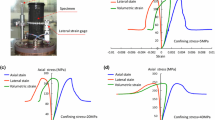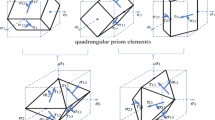Summary
-
1.
When rock specimens are tested under uniaxial compression, the scatter of results is a function of the structure, and can be expressed by a relation between the index under study and a factor which determines the strength of the rock.
-
2.
To analyze the structure of the scatter we propose a general form of the mean value, σav=σmaxp(δ).
-
3.
We propose a generalized homogeneity index ω, which is a more sensitive expression of the degree of homogeneity.
-
4.
As a first approximation we propose that rocks should be classified according to their degree of homogeneity by means of this index ω.
Similar content being viewed by others
Literature Cited
G. N. Kuznetsov and M. N. Bud'ko, Estimation of the influence of fissuring of a rock on its stability in a mine working, by the method of modeling. Reports to Seminar on Topics in Research on the Mechanical Properties of Rocks in Situ [in Russian], Leningrad, Izd. VNIMI (1964).
N. A. Filatov, Dependence of strength and deformation properties of specimens made of equivalent materials on the direction of their stratification. Rock Pressure, Rock Movement, and Survey Methods [in Russian], Symposium 60, Leningrad, Izd. VNIMI (1966).
N. G. Cook, The basic mechanics of rock bursts, I. S. Afric. Sust. Mining and Metallurgy, No. 4, 71–81 (1963).
Yu. G. Gribin, A. V. Isaev, Yu. A. Makhan'ko, D. V. Pogromskii, D. M. Turovtsev, and A. K. Kolegov, On determining the strength properties of rocks [in Russian], Fiziko-Tekhn. Probl. Razrab. Polezn. Iskop., No. 4 (1965).
V. D. Palii, Yu. D. Orlov, and I. I. Protopopov, Influence of fissuring and of the variation of mineralogical composition of rocks on the strength under uniaxial compression (a study of mineralized serpentinites of the Pechenga copper-nickel deposit), In symposium, “Rock Pressure, Rock Movement, and Survey Methods” [in Russian], No. 62, Leningrad, Izd. VNIMI (1966).
G. V. Tokhtuev, V. G. Klimenko, and S. G. Borisenko, Regular correspondences between the strength properties and geological-petrographic characteristics of the Krivoi Rog ores [in Russian], Tr. NIGRI,9, Moscow, Gosgortekhizdat (1964).
A. V. Pek, Fracturation Tectonics and Structural Analysis [in Russian], Moscow, Izd. AN SSSR (1939).
N. A. Eliseev, Structural Petrology [in Russian], Leningrad, Izd. Leningradskogo Univ. (1953).
G. D. Azhgirei, Structural Geology [in Russian], Moscow, Izd. Moskovskogo Gos. Univ. (1956).
Additional information
VNIMI, Leningrad. Translated from Fiziko-Tekhnicheskie Problemy Razrabotki Poleznykh Iskopaemykh, No. 4, pp. 45–52, July–August, 1967.
Rights and permissions
About this article
Cite this article
Protopopov, I.I. Some causes of the scatter of the strengths of rock specimens estimated during tests under uniaxial compression. Soviet Mining Science 3, 357–362 (1967). https://doi.org/10.1007/BF02497559
Received:
Issue Date:
DOI: https://doi.org/10.1007/BF02497559




